| |
STORIES, BOOKS & MEDIA

The majority of the following books are from the library of Chon Tri. Many of the summaries and in his own words. If you wish to purchase the book, click on the cover image and you will be linked to Amazon.com.
| Select a Category » |
[
Foundation
]
[
Practice
]
[
Sutra & Sastra
]
[
Koans
]
[
Works
]
[
History & References
]
[
Essays & Studies
]
[
Others
]
» Buy this book
» Recommend a Book
|
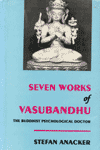
|
21. SASTRA: SEVEN WORKS OF VASUBANDHU, THE BUDDHIST PSYCHOLOGICAL DOCTOR
by Vasubandhu; Stefan Anacker (translator)
Publisher: Motilal Banarsidass (ISBN #: 0895812290, Hardcover, 490 pages, January 1995)
» Submit a review
Summary
This collection includes the Vada-Vidhi, a work on logic; the Pancaskandhakaprakarana, which deals with the 'aggregates' making up 'personality', the karmasiddhiprakarana, which attacks many features of earlier Buddhist psychology, the Vimsatika and Trimsika, which take Buddhist psychology into hitherto unexplored areas; the Madhyanta-Vibhagabhasya, books of Mahayana realization: and the Tri-svabhav-nirdesa, which shows a way for ridding consciousness of ensnaring mental constructions.
|
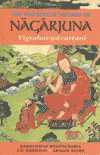
|
22. SASTRA: THE DIALECTICAL METHOD OF NAGARJUNA: VIGRAHAVYAVARTANI
by Nagarjuna, Kamaleswar Bhattacharya (translator)
Publisher: Motilal Banarsidass Publisher (ISBN #: 8120802152, Paperback, 143 pp, January 1998)
» Submit a review
Summary
Though only a 'minor work' in form, as regard its contents the Vigrahavyavartani, as well as a fundamental text of Madhyamaka, as well as the early Indian dialectical tradition. Not ony does it admirably illustrate the dialectical method follwed by Nagarjuna, the founder of the school, but it also clarifies the idea of Sunyata (Emptiness) which has been so often misunderstood, not only in modern times aborad, but in India itself and in Nagarjuna's own time. (From the front flap of the book).
|
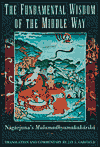
|
23. SASTRA: THE FUNDAMENTAL WISDOM OF THE MIDDLE WAY: NAGARJUNA'S MULAMADHYAMAKAKARIKA
by Nagarjuna - Jay L. Garfield (translator)
Publisher: Oxford University Press (ISBN #: 0195093364, Paperback, 400 pp, August 1995)
» Submit a review
Summary
Book Description
The Buddhist saint Nagarjuna, who lived in South India in approximately the second century CE, is undoubtedly the most important, influential, and widely studied Mahayana Buddhist philosopher. His many works include texts addressed to lay audiences, letters of advice to kings, and a set of penetrating metaphysical and epistemological treatises. His greatest philosophical work, the Mulamadhyamikakarika--read and studied by philosophers in all major Buddhist schools of Tibet, China, Japan, and Korea--is one of the most influential works in the history of Indian philosophy. Now, in The Fundamental Wisdom of the Middle Way, Jay L. Garfield provides a clear and and eminently readable translation of Nagarjuna's seminal work, offering those with little of no prior knowledge of Buddhist philosophy a view into the profound logic of the Mulamadhyamikakarika.
|
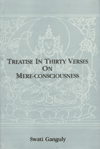
|
24. SASTRA: TREATISE IN THIRTY VERSES ON MERE-CONSCIOUSNESS: A CRITICAL TRANSLATION OF HSUAN-TSANG'S CHINESE VERSION OF THE VIJNAPTIMATRATATRIMSIKA WITH NOTES
by Vasubandhu; Sawati Ganguly (translator)
Publisher: Motilal Banarsidass Pub (ISBN #: 8120809245, Hardcover: 271 pages, November 1999)
» Submit a review
Summary
The book explores the developments and the various implications of the doctrine of Mere-consciousness. It aims at evaluating and reconstructing the patterns of Buddhist idealism from the Sanskrit and Chinese sources. It contains a comprehensive translation with interpretation of the basic Yogacara-Vijnanavada texts preserved in Chinese.
|
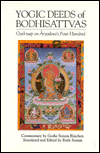
|
25. SASTRA: YOGIC DEEDS OF BODHISATTVAS: GYELTSAP ON ARYADEVA'S FOUR HUNDRED
by Aryadeva - Sonam Rinchen - Ruth Sonam (translator)
Publisher: Snow Lion Publications, Incorporated (ISBN #: 1559390190, Paperback, 400 pp, January 1994)
» Submit a review
Summary
Reviewer: Nicola Hernà di,ABU-concept@t-online.de (Berlin, Germany)
"In the " 400 stanzas", Aryadeva, an ancient indian saint, famous scholar of Nagarjuna, explains, how to regard life out of Buddhist insight. His compressed verses show a radical wit, provoking the readers' contradiction, making them think about the actual meaning.
To unfold the contents of Aryadeva's mental seeds, comments and explaining stories have been added by following Indian and Tibetan Buddhist personalities, which are a pleasure to read, due to their poetical, funny and colourful descriptions of how to consider apparently common situations in a refreshing new way.
Geshe Rinchen La rounds up each chapter, summarizing the essentials, clearing them from the narrative ornaments to emphasize their advice for the present time. 'Though dealing with highly complex philosophical subjects, this book is earth-bound as life itself. It fascinates in combining a thousand years of Buddhist spirit, serving to improve human life through changing ones own mental influence on it.
|
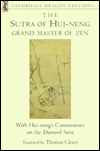
|
26. SUTRA OF HUI-NENG
by Thomas Cleary (translator)
Publisher: (ISBN #: 1570623481, 6x9x0.5 - Soft cover - 161 pp, January 1998)
» Submit a review
Summary
This record of the Discourses of Grand Master of Zen Hui-neng was the only one Zen record classified as a Sutra beside the Sutras which recorded the Sayings of the Buddha himself.
Translated form Chinese by Thomas Cleary
|
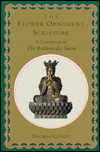
|
27. SUTRA: FLOWER ORNAMENT SCRIPTURE, A TRANSLATION OF THE AVATAMSAKA SUTRA
by Thomas Cleary (translator)
Publisher: Shambhala (ISBN #: 0877739404, 6x9x2.1/4 - Hard cover - 1643 pp, January 1993)
» Submit a review
Summary
This Sutra is teaching on the totality. Many Zennists used it to develop their insight after kensho.
Translated from Chinese version by Thomas Cleary.
|
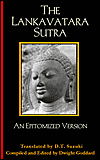
|
28. SUTRA: LANKAVATARA SUTRA
by Daisetz Teitaro Suzuki (translator)
Publisher: Routledge & Kegan Paul LTD (ISBN #: 0972635742, 5.5x8.5x1.1/4 - Hardcover, 128pp, November 2003)
» Submit a review
Summary
According to the Zen tradition, this is the first Sutra was assigned to Zen practitioners by Bodhidharma, the first Patriarch of Zen.
Translated from Sanskrit by D. T. Suzuki
|
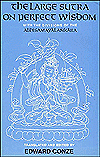
|
29. SUTRA: LARGE SUTRA ON PERFECT WISDOM
by Edward Conze (translator)
Publisher: University of California Press (ISBN #: 0520053214, 5.5x8.1/4x2 3/4 - Soft cover - 679 pp, January 1994)
» Submit a review
Summary
This sutra belongs to Mahayana Buddhism and one of the most important sutras of Buddhism. It especially deals with Prajna or the Perfect Wisdom and Sunyata or the Emptyness, two sides of the same Reality.
Translated from Sanskrit by Edward Conze
|
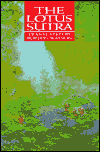
|
30. SUTRA: LOTUS SUTRA
by Kumalajiva, Burton Watson (translators)
Publisher: Columbia University Press (ISBN #: 023108160X, Hardcover: 359 pages , June 1993)
» Submit a review
Summary
FROM THE PUBLISHER
Since its appearance in China in the third century, the Lotus Sutra has been regarded as one of the most illustrious scriptures in the Mahayana Buddhist canon. The object of intense veneration among generations of Buddhists in China, Korea, Japan, and other parts of East Asia, it has attracted more commentary than any other Buddhist scripture and has had a profound impact on the great works of Japanese and Chinese literature. Conceived as a drama of colossal proportions, the text takes on new meaning in Burton Watson's translation. Depicting events in a cosmic world that transcends ordinary concepts of time and space, the Lotus Sutra presents abstract religious concepts in concrete terms and affirms that there is a single path to enlightenment - that of the bodhisattva - and that the Buddha is not to be delimited in time and space. Filled with striking imagery. memorable parables, and countless revelations concerning the universal accessibility of Buddhahood, the Lotus Sutra has brought comfort and wisdom to devotees over the centuries and stands as a pivotal text in world literature. As Watson notes, "The Lotus Sutra is not so much an integral work as a collection of religious texts, an anthology of sermons, stories and devotional manuals, some speaking with particular force to persons of one type or in one set of circumstances, some to those of another type or in other circumstances. This is no doubt one reason why it has had such broad and lasting appeal over the ages and has permeated so deeply into the cultures that have been exposed to it."
|
|
|

SUPPORT ZENGUIDE.COM

Purchase posters, art prints, media (music CD & DVD)
 TRANQUILITY, HARMONY, SERENITY, PEACE
TRANQUILITY, HARMONY, SERENITY, PEACE
by
→Puchase this Item
→More Art Prints & Media
→Zen & Buddhism books
|
|
|
s
.
t
.
o
.
r
.
i
.
e
.
s
.
,
.
.
b
.
o
.
o
.
k
.
s
.
.
&
.
.
m
.
e
.
d
.
i
.
a
.
|















 TRANQUILITY, HARMONY, SERENITY, PEACE
TRANQUILITY, HARMONY, SERENITY, PEACE









